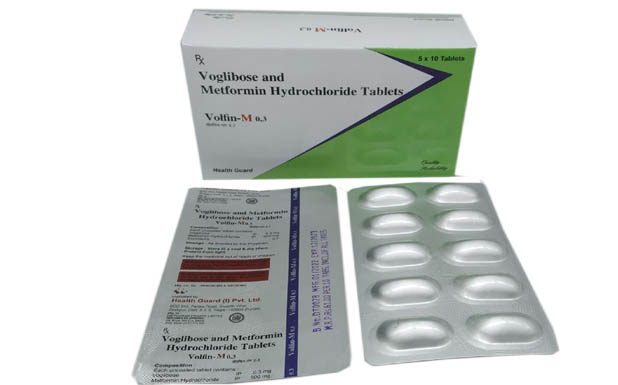Metformin is an oral antidiabetic drug in the biguanide class. It is the first-line drug of choice for the treatment of type 2 diabetes, in particular, in overweight and obese people and those with normal kidney function.
Indications
For the treatment of diabetes. It is specifically used for lowering post-prandial blood glucose levels thereby reducing the risk of macrovascular complications.
Rationale of Combination
● Metformin is the only antidiabetic drug that has been conclusively shown to prevent the cardiovascular complications of diabetes. It helps reduce LDL cholesterol and triglyceride levels, and is not associated with weight gain.
● It is also used in the treatment of polycystic ovary syndrome, and has been investigated for other diseases where insulin resistance may be an important factor.
Drug Interaction
Voglibose:
When voglibose is used in combination with derivative(s) of sulfonylamide, sulfonylurea or biguanide, or with insulin, hypoglycemic symptoms may occur. Therefore, when used in combination with any of these drugs, care should be taken, such as starting the administration at a low dose.
When voglibose is administered concomitantly with drugs that enhance or diminish the hypoglycemic action of antidiabetic drugs, caution should be taken as this might additionally delay the action of voglibose on the absorption of carbohydrates. Examples of drugs enhancing the hypoglycemic action of antidiabetic drugs: βblockers, salicylic acid preparations, monoamine oxidase inhibitors and fibrate derivatives. Examples of drugs diminishing the hypoglycemic action of antidiabetic drugs: epinephrine, adrenocortical hormone, and thyroid hormone.
Metformin:
The following medicines may interact with Metformin hydrochloride:
● insulin
● antihypertensives
● diuretics
● glucocorticosteroids
● iodinated contrast media
● loop diuretics
● meglitinides
● non-steroidal anti-inflammatories
● other oral antidiabetics
● sulphonylureas
● sympathomimetics
Mechanism of Action
Voglibose:
Voglibose is an alpha-glucosidase inhibitor which reduces intestinal absorption of starch, dextrin, and disaccharides by inhibiting the action of α-glucosidase in the intestinal brush border. Inhibition of this enzyme halts the decomposition of disaccharides into monosaccharides and slows the digestion and absorption of carbohydrates; the postprandial rise in plasma glucose is blunted in both normal and diabetic subjects resulting in improvement of post-prandial hyperglycemia and various disorders caused by hyperglycemia. α-glucosidase inhibitors do not stimulate insulin release and therefore do not result in hypoglycemia.
Metformin:
Metformin is a biguanide with antihyperglycemic effects, lowering both basal and postprandial plasma glucose. It does not stimulate insulin secretion and therefore does not produce hypoglycemia. Metformin may act via 3 mechanisms:
● By reducing hepatic glucose production through inhibition of gluconeogenesis and glycogenolysis.
● By increasing insulin sensitivity in muscle, improving peripheral glucose uptake and utilization.
● By delaying intestinal glucose absorption.
Pharmacokinetics
Voglibose:
Absorption: Voglibose is poorly absorbed after oral dosing. Plasma concentrations after oral doses have usually been undetectable.
Distribution: After ingestion of voglibose (and other glucosidase inhibitors), the majority of active unchanged drug remains in the lumen of the gastrointestinal tract to exert its pharmacological activity.
Metabolism: Voglibose is metabolized by intestinal enzymes and by the microbial flora.
Elimination: Voglibose is excreted in the urine and feces.
Metformin:
Absorption: After an oral dose of metformin, time to peak plasma concentration (Tmax) is reached in 2.5 hours. Absolute bioavailability of a 500 mg metformin tablet is approximately 50% to 60% in healthy subjects. Food decreases the extent of absorption and slightly delays absorption.
Distribution: Plasma protein binding is negligible. Metformin partitions into erythrocytes. The blood peak is lower than the plasma peak and appears approximately the same time. The red blood cells most likely represent a secondary compartment of distribution. The mean Vd ranges between 63 to 276 L.
Metabolism: Metformin is excreted unchanged in urine. No metabolites have been identified in humans.
Elimination: Renal clearance of metformin is >400 ml/min, indicating that metformin is eliminated by glomerular filtration and tubular secretion. Following an oral dose, the apparent terminal elimination half-life is approximately 6.5 hours. When renal function is impaired, renal clearance is decreased in proportion to that of creatinine and thus the elimination half-life is prolonged, leading to increased levels of metformin in plasma.
Common Side Effects
Gastrointestinal disorders such as, abdominal pain, constipation, anorexia, nausea, vomiting, diarrhea, and loss of appetite.
Contraindications
● Hypersensitivity to metformin, voglibose, or to any of the excipients
● Diabetic ketoacidosis, diabetic pre-coma
● Severe infection, before and after operation or with serious trauma
● Gastrointestinal obstruction or predisposed to it
● Renal failure or renal dysfunction (creatinine clearance ˂ 60 ml/min)
● Acute conditions with the potential to alter renal function such as:
dehydration
severe infection
shock
intravascular administration of iodinated contrast agents
● Acute or chronic disease which may cause tissue hypoxia such as:
cardiac or respiratory failure
recent myocardial infarction
shock
Hepatic insufficiency, acute alcohol intoxication, alcoholism
In Pregnancy and Lactation: To date, no relevant epidemiological data are available. Animal studies do not indicate harmful effects with respect to pregnancy, embryonal or fetal development, parturition or post natal development, therefore the drug should be given to pregnant women or women suspected of being pregnant only when the potential benefits outweigh the possible hazards.
Storage
Store in a cool, dry place.
Protect from light.
Keep the medicine out of reach of children.
Disclaimer:The data uploaded is made from content already available on internet.The company holds no right of it and is not responsible for any wrong information.
